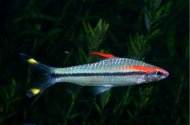The Redline Torpedo Barbs have been proposed to be included in a new genus named Sahyadria. The two species of fishes (chalakkudiensis and denisonii) which were till date placed in the genus Puntius will now be under the new genus, Sahyadria – named after the Western Ghats mountain ranges to which these fishes are endemic to.

There had been much uncertainty on the exact generic position of these fishes since the time they were described from Kerala, over a century and a half ago by the British naturalist Sir Francis Day. Taxonomists confused over its correct identity had placed these fishes under different genera like Barbus, Labeo, Puntius and Hypselobarbus.
A team of researchers, Rajeev Raghavan and Anvar Ali from the Conservation Research Group at St. Albert’s College, Kochi; Neelesh Dahanukar from the Indian Institute of Science Education and Research, Pune and myself carried out detailed osteological and molecular studies to finally clarify the riddle surrounding the exact identity of these fishes. The result of their study identifying and naming the new genus Sahyadria has been published today in the Journal of Threatened Taxa – an international journal of taxonomy and conservation.
Recently, the same team of researchers had suggested that there is a huge undescribed diversity existing within the fishes currently known as Redline Torpedo Barbs, and had indicated the presence of at least six ‘evolutionarily distinct lineages’ apart from the two known species (Sahyadria denisonii and Sahyadria chalakkudiensis).
Redline Torpedo Barbs are extremely popular fishes in the international aquarium pet trade and their indiscriminate exploitation from the wild has led to their ‘Endangered’ listing in the IUCN Red List of Threatened Species.
References:
Raghavan, R., S. Philip, A. Ali & N. Dahanukar (2013). Sahyadria, a new genus of barbs (Teleostei: Cyprinidae) from Western Ghats of India. Journal of Threatened Taxa 5(15): 4932–4938; http://dx.doi.org/10.11609/JoTT.o3673.4932-8
John, L., S. Philip, N. Dahanukar, A. Ali, J. Tharian, R. Raghavan & A. Antunes (2013). Morphological and genetic evidence for multiple evolutionary distinct lineages in the endangered Red-lined Torpedo Barbs – highly exploited freshwater fishes endemic to the Western Ghats Hotspot, India. PLoS ONE 8(7): e69741; http://dx.doi.org/10.1371/journal.pone.0069741
Raghavan, R., N. Dahanukar, M. Tlusty, A. Rhyne, K. Krishnakumar, S. Molur & A. Rosser (2013). Uncovering an obscure trade: threatened freshwater fishes and the aquarium pet markets. Biological Conservation 164: 158–169; http://dx.doi.org/10.1016/j.biocon.2013.04.019
